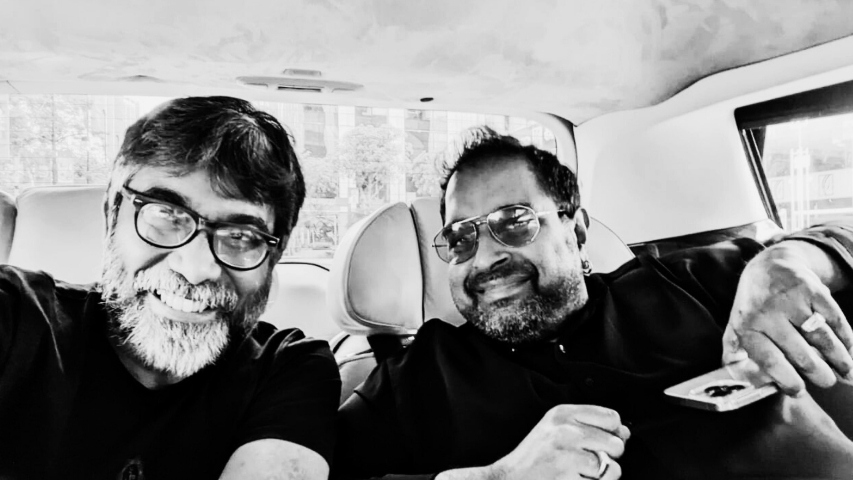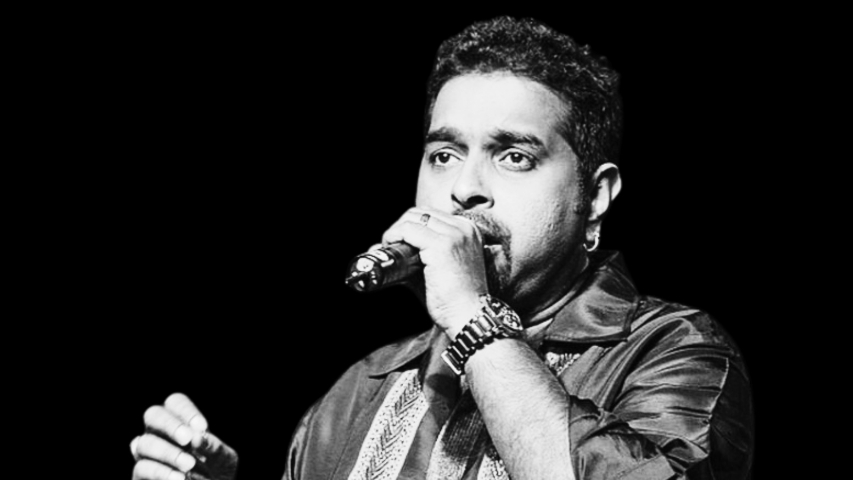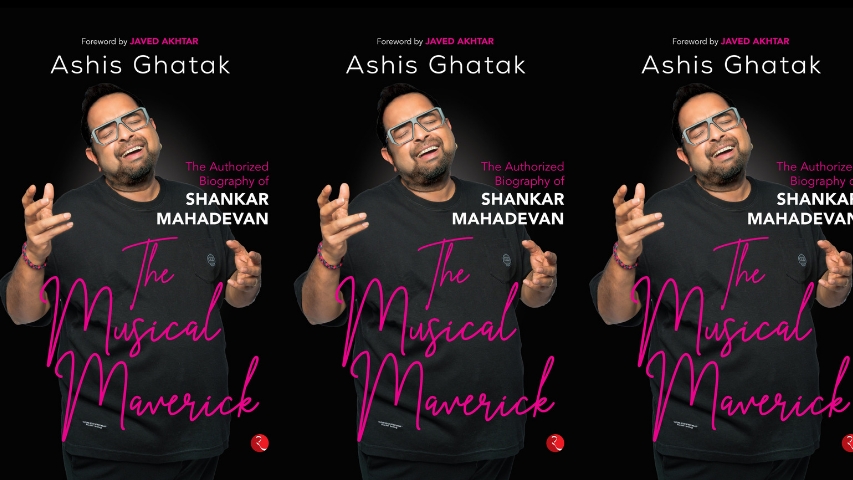-853X543.jpg)
KALEIDOSCOPE: THE MUSICAL MAVERICK BY ASHIS GHATAK
by Vinta Nanda March 19 2024, 12:00 am Estimated Reading Time: 12 mins, 27 secsVinta Nanda talks to Ashis Ranjan Ghatak, biographer of ‘The Musical Maverick: The Authored Biography of Shankar Mahadevan’ about his process and the vast journey he took to emerge with this breathless story.
Extensively researched and packed with endearing incidents and enduring accounts from the life of an artist who has been hailed as one of the greatest of all time, the biography captures Shankar at his most multifaceted: singer, musician, composer, friend, family man, guru, and ultimately, iconic artist.
Drawing on many hundred hours of interviews with Shankar, author Ashis Ranjan Ghatak paints the complete picture of a man who effortlessly glides into each of his facets with the same amount of passion and energy. Despite the fame and accolades, Shankar Mahadevan still identifies as a regular boy from Mumbai’s Chembur.
“The candour and honesty with which Shankar narrates his journey is extremely rare for a man of his stardom”, says Ashis. In The Musical Maverick, Shankar reveals that he trained to become a veena artiste in his childhood. While teaching him to play a kriti, his veena guru told him to also sing it in order to execute it well, thereby setting off his interest in singing. This eventually led to the formation of the legendary composer-trio: Shankar–Ehsaan–Loy. His singing career was no less spectacular, with songs like ‘Suno Gaur Se Duniya Walo’, still a must at every event of national importance - sporting, cultural or otherwise.
Ashis Ranjan Ghatak, by profession a mentor teaching English in a government-aided school in Kolkata, is a film and music enthusiast, a photographer and an avid traveller. He has to his credit many academic books and travelogues in various magazines. His previous book, Louiz Banks: A Symphony of Love, received rave reviews. His latest, ‘The Musical Maverick’ is the first and only definitive authorized biography of a talent that emerges once a century - Shankar Mahadevan.
I had a conversation with the author about his writings and other things. Over to him then…

After Louis Banks, it is Shankar Mahadevan - was the line-up planned by you for, or did it just happen?
Nothing was planned as such. It just happened though I had a wish of writing a book on music. Writing on Louiz banks was providential. My association with the R.D. Burman foundation, Euphony, helped me reach Mr Banks as Euphony does R.D Burman tribute shows with his original musicians. Louiz Banks had been a significant musician in R.D. Burman’s team for more than twelve years.
Shankar Mahadevan happened because of my love for the music of ‘Shankar Ehsaan Loy (SEL)’. Since R.D Burman, my most favourite were Jatin Lalit of the 1990s and SEL for the last 25 years. I met Shankar while interviewing him for my first book. I couldn’t drop a proposal of writing on him when Shankarji came to launch my biography on Louiz Banks. I was so fortunate when he allowed me to write with the reply, “Yeah, if you feel I’m worthy of it, please go ahead’. Things just fell in place after that.
What draws you to the two artists?
Their personalities. Their goodness. Their humility. And the way they have been the flag bearers of Indian music to the world with their art. Coming across a man like Louiz Banks is a blessing. Reigning as the Godfather of Indian Jazz, his modesty and goodness is overwhelming. And why only jazz, he was not to be compartmentalised into any specific category.
Same is applicable to Shankar Ji. Both Louiz Sir and Shankar ji are versatile and nonconformists. Shankar Mahadevan is a fountainhead of joy. His very presence is magical. One can’t stay out of the sheer liveliness and positivity of his persona when one comes near him. Knowing him as a person is delightful.
What was the process you adopted to work on The Musical Maverick and what are the things you discovered along the way about Mahadevan, which you didn't know earlier?
I adopted the simple procedure of telephonic and in-person interviews, zoom interviews and email conversations with Shankar ji. I visited Mumbai to meet his colleagues and acquaintances. Each one I came across while writing the book has been extremely helpful and co-operative.
I came to know different shades of this man of which I hardly had any idea. The most attractive thing I found is how he knows to live in every single moment. How immersed he is in every single thing he does, how much he is involved in every single word he speaks. How he makes anyone feel special with the way he behaves and talks with him. While among so many people around how he can connect with you personally, and once he is through his job, how he retires to his family and finds a world of joy there. I got to know about his childhood, his simple household, the delightful stories of his friends and an adorable love story with his childhood sweetheart who eventually became the most significant part of his life.
When I met the trio in Purple Haze, their studio, I had the experience of a lifetime when I saw how songs are born, in front of me.

Do give us insights into writing biographies of artists like Louis Banks and Shankar Mahadevan.
Choosing the subject of a biography is a tricky part, especially if the life story of your subject isn’t that dramatically eventful. It may fall flat with the readers. As a reader of biography, a linear sketch of the subject’s biographical details appear much less attractive to me than the art, which he deals in. But as a biographer, the chronological tracking of the subject’s life becomes important as well. There I faced the challenge of where to draw the line as one cannot be substantiated without the other.
The next challenge I found is to strike a balance between how you internalise the subject’s life and its detached observer at the same time. One has to lead the life of the person on whom one is writing but one has to be conscious lest the biography ends up bordering on hagiography.
However, writing biographies of Louiz Banks and Shankar Mahadevan gave me great opportunities to relive the time I hadn’t witnessed in person. History turned into a reality for me as an author. Things seemed to happen in front of my eyes, the writer was going places with the subject of his biography. This indeed was a great experience.
Also, tell us about your interest in music and photography. Where do the two meet, where they don't?
The point of similarity between photography and music is definitely both being the medium of teleporting one’s mind into an idyllic solitude where you converse with your alter ego. I also think that deep down you reflect your own persona through the photographs you click and the music you love.
And the point of departure: Well I haven’t thought like that. But yes, photography helps me write poems with visual images which I never dared to write on paper, though I had wished I did. So the concrete images of photographs are an extension of my abstract thoughts. But music is out and out abstract in its shape and colour.
What do you plan ahead of this?
You know when you start writing a book it is like a journey on a highway through the meadows and rice fields. It is adventurous and every turn awaits you with unknown vistas. But after a certain point you long to see the crowds, the market places, the neighbourhoods, people moving around and talking to one another. After finishing this book, I now feel the urge to take a pause, look around, have a glass of tea at a wayside stall before embarking on a new voyage.
EXTRACT:

When Shankar met the quiet and self-effacing Ehsaan at Ranjit’s house, he had no clue as to who he was. Soon after, Ehsaan called him to sing a jingle for an ayurvedic tablet called Trishun - a medicine for cough and cold. The small ditty on the ayurvedic ‘sardi zukham wala goli’ - ‘Mausam badla din badla sardi zukam ka hamla’ - is a fond memory for them.
They did several jingles together, but the jingle scored for Baygon Power Mats, one of the first ones that Ehsaan composed for Shankar, has an interesting story attached to it. Ehsaan recalls, ‘The original one was done by a rapper who had a tough time doing it. Shankar came in and did this jingle in all four South Indian languages just like that and walked out of the studio in just 20 minutes. That was the kind of talent he had.’
Together, they worked a lot in days to come but both of them fondly recall one ad in particular. It was the ever so melodious ‘Kabhi Zindagi Se Bhare’ for Cadbury’s Perk which was first made memorable by Rajeshwari and then by a chirpy and nubile Preity Zinta.
When Shankar was entering the jingle industry, getting a chance to playback for films wasn’t easy. The production houses were not liberal enough to try out new voices. On the contrary, the ad industry was more open. Shankar was known as a guy who would come, read the jingle, have a couple of takes and finish it off. Soon, he became the most sought-after jingle singer. Shankar was clubbed in many projects with Ehsaan and Loy. Slowly, the three formed a team of producing jingles. Ehsaan would compose and Loy used to do the programming bit. Shankar would obviously be the singer. Once, they were doing an ad for a fabric company and Shankar was at the studio to sing. The set-up attracted Shankar so much that he ended up trying his hand at programming the sitar and tabla parts.
People took notice of his ability to sing all kinds of songs in many languages, and also noticed that he could play various instruments. That was the beginning of the three like-minded artists spending substantial time in the small interiors of various recording studios like Four D, Music Room, Western Outdoor, Radio Vani or Digital Domain.
Ehsaan and Loy were extremely easy people to work with. They always welcomed Shankar’s contribution to the track. There was no thought of forming a trio in those days, but the camaraderie helped forge a bond based on love, trust and shared experiences of music. One day, Ehsaan got a call from Mukul Anand. This was for a Pepsi commercial with Ehsaan and Loy, and Shankar was called to sing. Mukul and Ehsaan were very close friends. During the making of that Pepsi commercial, Mukul asked him to compose the title track for the TV serial Hum. It was to be aired on Zee and Ehsaan chose Shankar as the singer. Though the serial was unfortunately shelved, Mukul heard the song and loved the track and the voice. He was planning to make a film, a magnum opus of a kind and he told Ehsaan that he would like him to join in as the music composer for the film. Instead of feeling excited, Ehsaan’s first reaction was to shudder at the very thought of composing music for mainstream Hindi movies. He was too apprehensive of diving into it because he wasn’t a big lover of contemporary Hindi film music. But Mukul was an endearing friend and on his insistence, Ehsaan gave it a thought. Finally, he came up with the condition that he could accept the proposal if he could bring in his two friends, Shankar and Loy, along with him. Mukul assured him that he could bring in 10 people if required.
Since they had been working in the advertising industry for a long time, while writing the tune of the first song, they made use of certain components of jingles. Instead of the loud and orchestral music of Mukul’s earlier feature films, they had in mind a composition with minimal orchestration.
Their first film song had a soft and gentle ambient sound on which Shankar wrote the melody. Loy came up with the idea of using a little tinkling sound in between. He wanted the music to breathe life in-between the lyrics. They decided not to add any other instruments except that brief percussive sound in a loop. That little sound gave a different edge to the track. Shankar brought out the delicate nuances of the metaphors that the lyricist Sameer had used to describe an ethereal beauty, when he sang the song ‘Chandni Roop Ki’. For the song, when Sameer wrote the word ‘surmai’, Ehsaan couldn’t understand it. He thought that it was the surmai fish available in Goa. Shankar later told him that it was not the fish but the kohl put on eyes. Mukul was ecstatic upon hearing the song. He had no questions to ask and decided that they would compose the remaining tracks as well. That marked the beginning of a glorious phase of their lives.
It was in 1996 that an unsigned bond of exemplary togetherness was formed. The musical voyage of Shankar–Ehsaan–Loy (SEL) had begun. It was the dawn of a new day. The band of three young men barged into the living room with guitars, amplifiers, upright basses and microphones in hand. They entered like a breeze of fresh air. The monochrome frames instantly turned multi-coloured and Shankar started to croon: ‘Hai naya is dil mein ek tarana, mujhe baadalon se unche unche hai jaana (There is something new in this heart, I want to go higher than the clouds).’ The words reflect the yearning of the singer. This is how SEL heralded a new beginning for mainstream music.
As the band jazzed up the caffeinated morning with strums of guitar and tugs at the double bass, the entire mood gets livened up. Their music comes a whiff of positivity, mirth and youthfulness. The lyrics of the Nescafé song that came 16 years after this are testament to the time when the three took the musical scene by storm: ‘Sunke awaaz dil ki, Mujhe raaste nayee hai banana (Listening to the voice of my heart, I want to create a new road).’ The slogan of the iconic Nescafé ad - ‘Good Music, Good Life’ - echoes the hope that these three brought into the world of Hindi film music.




-173X130.jpg)
-173X130.jpg)

-173X130.jpg)
-173X130.jpg)
-173X130.jpg)
-173X130.jpg)
-173X130.jpg)